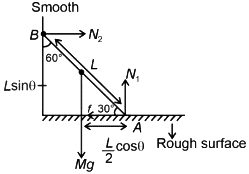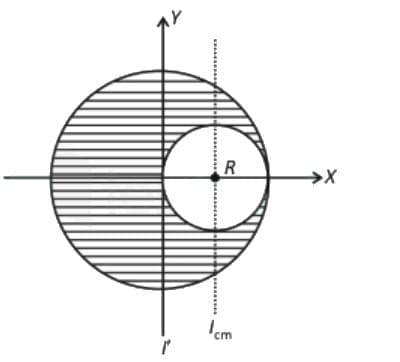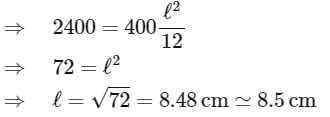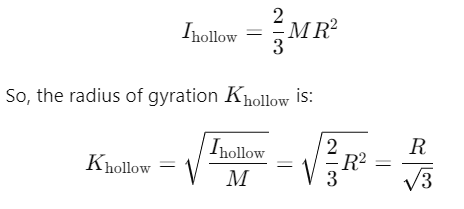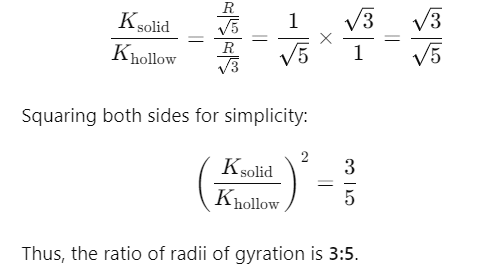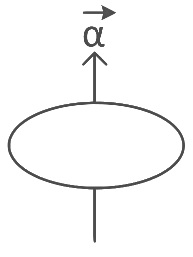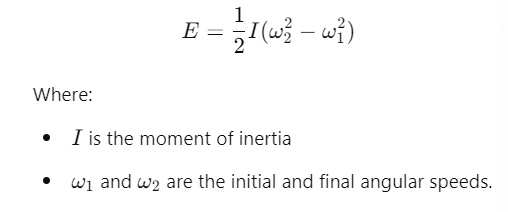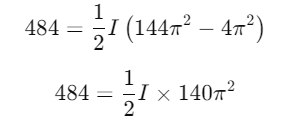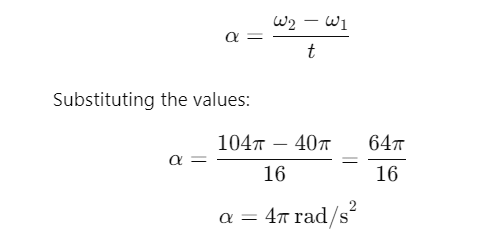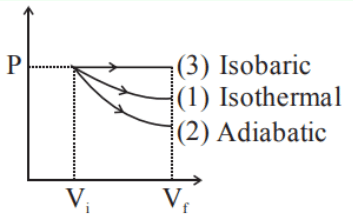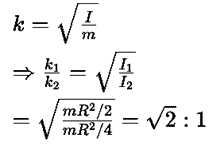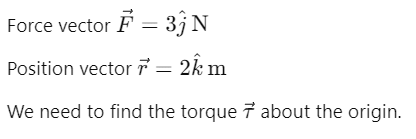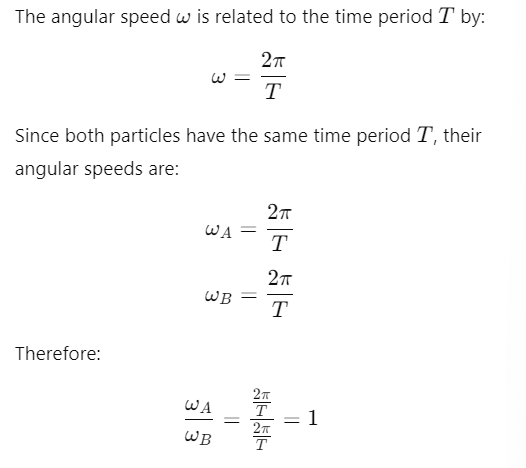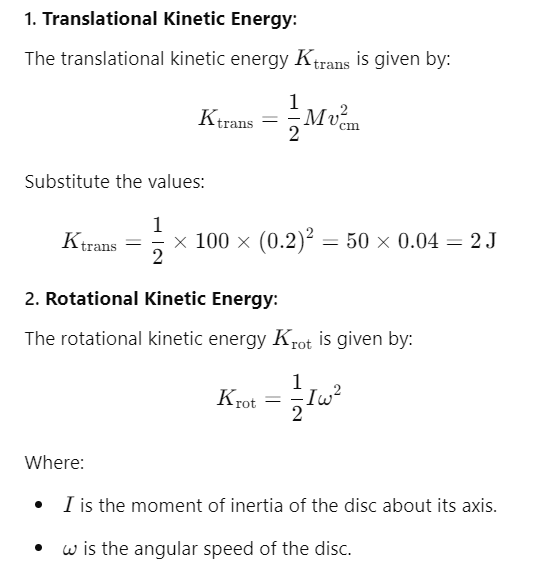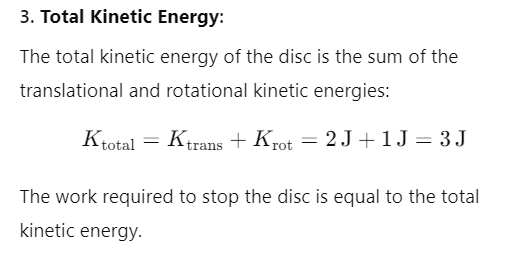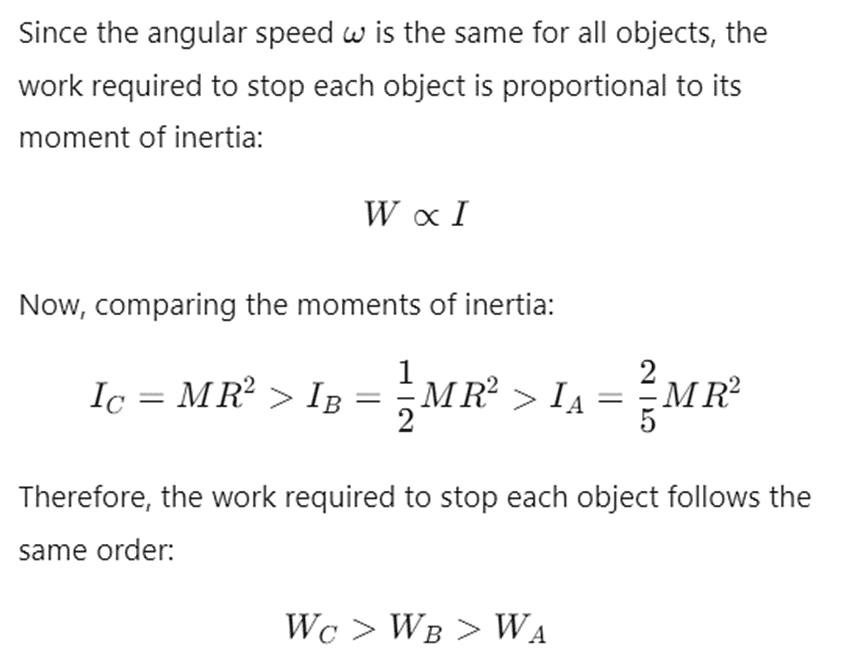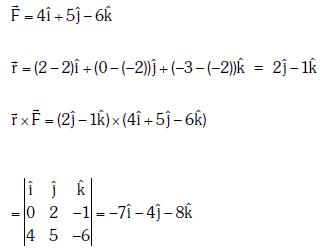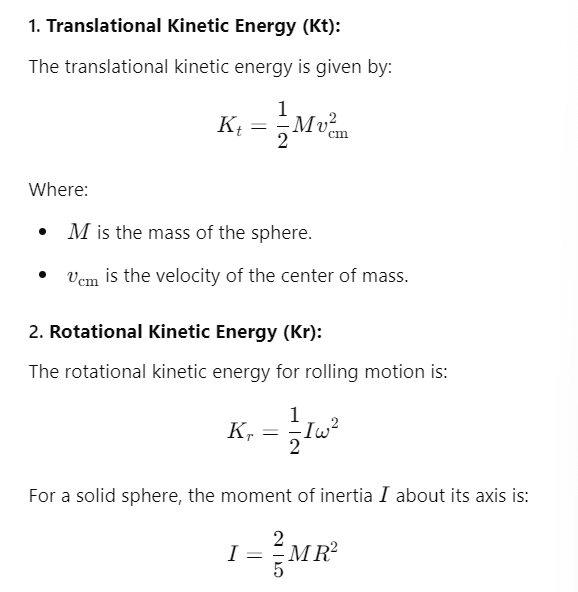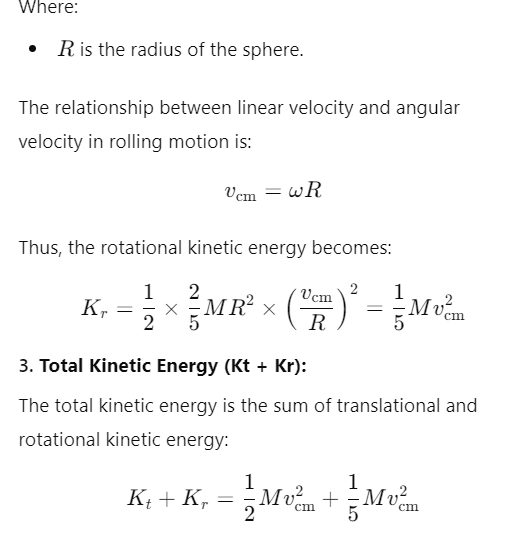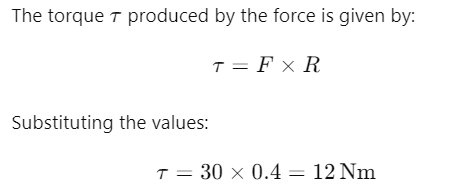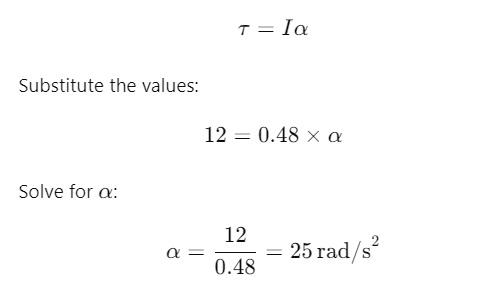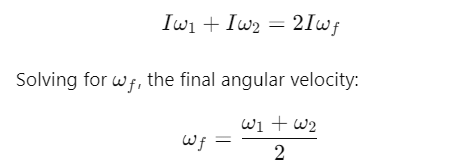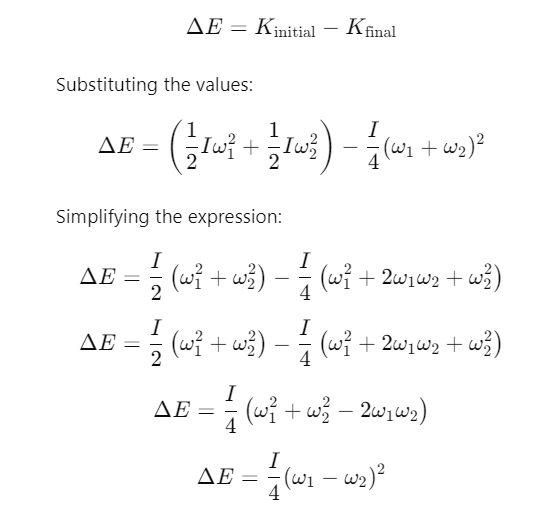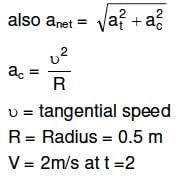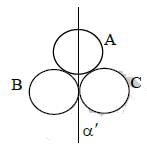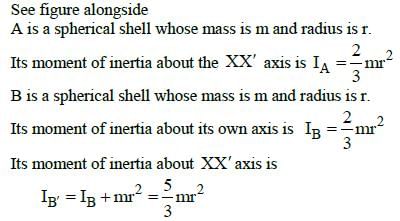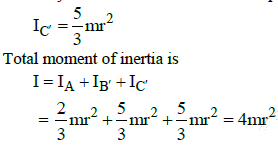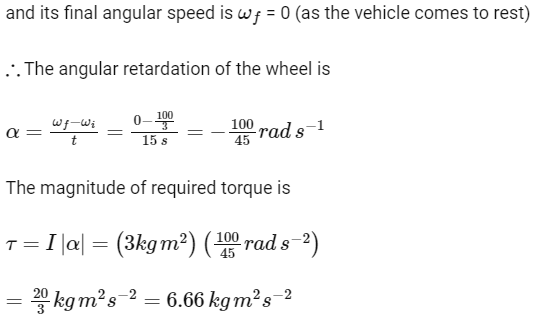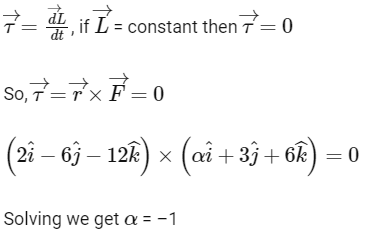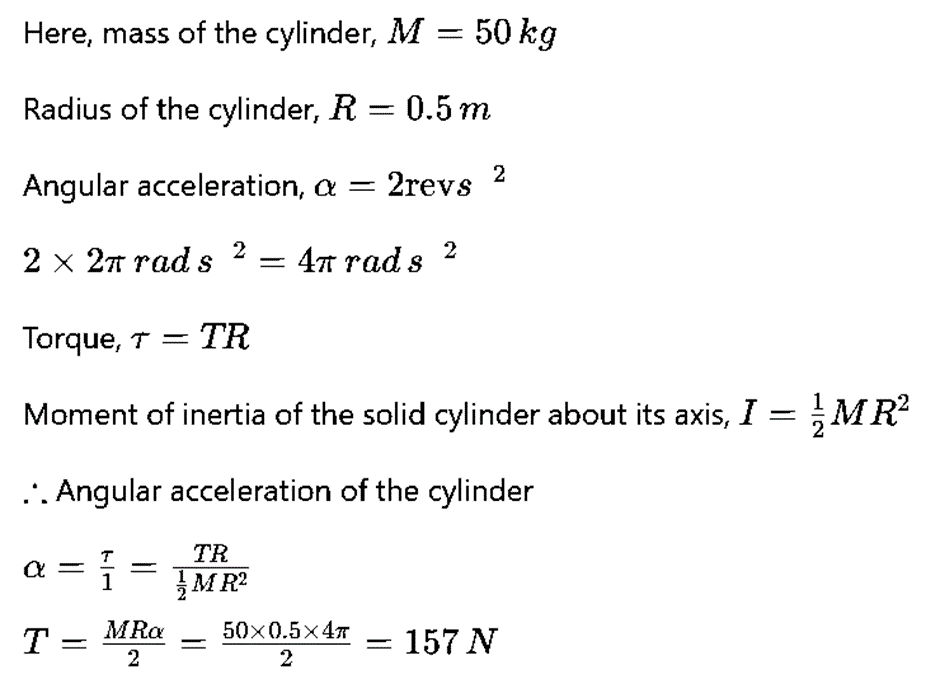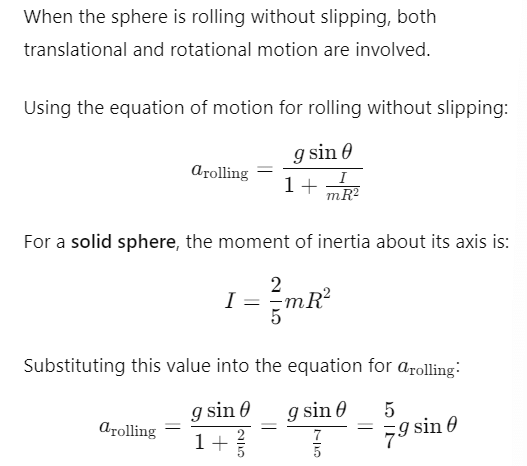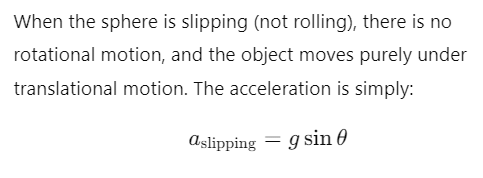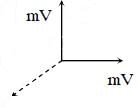NEET Previous year questions (2014-2025): System of Particles & Rotational Motion | Physics Class 11 PDF Download
2025
Q1: A uniform rod of mass 20 kg and length 5 m leans against a smooth vertical wall making an angle of 60∘ with it. The other end rests on a rough horizontal floor. The friction force that the floor exerts on the rod is: (take g = 10 m/s2) [2025]
(a) 200N
(b) 200√3N
(c) 100N
(d) 100√3N
Ans: (d)
For translational equilibrium
N1 = Mg
N2 = f
For rotational equilibrium
Torque about A, MgL/2 cosθ = N2L sinθ
(Mg/2) cotθ = N2 = f
(Mg/2) cot 30° = f
(Mg/2) √3 = N2
100√3 = f
Q2: The sun rotates around its centre once in 27 days. What will be the period of revolution if the sun were to expand to twice its present radius without any external influence? Assume the sun to be a sphere of uniform density. [2025]
(a) 115 days
(b) 108 days
(c) 100 days
(d) 105 days
Ans: (b)
Assuming the Sun to be a solid sphere, I = (2/5) m R2
Using conservation of angular momentum, I'ω' = Iω
⇒ (2/5) m (2R)2 × (2π / T') = (2/5) m R2 × (2π / T)
⇒ T' = 4T = 4 × 27 = 108 days
Q3: A sphere of radius R is cut from a larger solid sphere of radius 2 R as shown in the figure. The ratio of the moment of inertia of the smaller sphere to that of the rest part of the sphere about the Y -axis is: [2025]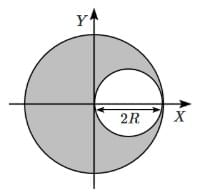 (a) 7/57
(a) 7/57
(b) 7/64
(c) 7/8
(d) 7/40
Ans: (a)
For a larger solid sphere about diameter Y-axis:
Iwhole = (2 / 5) × M × (2R)² = (8 / 5) × M × R²
Density of sphere is uniform:
M / Vwhole = Msmaller / Vsmaller
M / ((4/3)π(2R)³) = M′ / ((4/3)πR³)
⇒ M′ = M / 8
Using parallel axis theorem for smaller sphere:
I′ = Icm + M′ × R² = (2 / 5) × (M / 8) × R² + (M / 8) × R² = (7 / 40) × M × R²
Ratio:
Ratio = Ismaller / Iremaining = I′ / (Iwhole − I′)
= ((7 / 40) × M × R²) / (((8 / 5) − (7 / 40)) × M × R²)
= 7 / 57
2024
Q1: The moment of inertia of a thin rod about an axis passing through its mid point and perpendicular to the rod is 2400gcm2. The length of the 400g rod is nearly: [2024](a) 8.5 cm
(b) 17.5 cm
(c) 20.7 cm
(d) 72.0 cm
Ans: (a) 8.5 cm
Explanation:
Moment of Inertia of rod =
Q2: A wheel of a bullock cart is rolling on a level road as shown in the figure below. If its linear speed is v in the direction shown, which one of the following options is correct (P and Q are any highest and lowest points on the wheel, respectively)? [2024]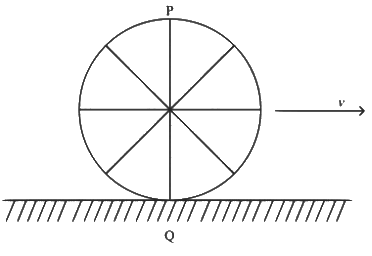 (a) Point P moves slower than point Q
(a) Point P moves slower than point Q
(b) Point P moves faster than point Q
(c) Both the points P and Q move with equal speed
(d) Point P has zero speed
Ans: (b) Point P moves faster than point Q
Explanation:
In the case of pure rolling,
The linear speed of the centre of the wheel is Q are the highest and lowest points on the wheel, respectively.
For rolling motion, every point on the wheel has two components of velocity:
- The translational velocity due to the movement of the entire wheel (
- The rotational velocity due to the wheel spinning. The velocity of a point on the rim is R is the radius of the wheel).
- For the topmost point (P):
(i) The translational velocity is
(ii) The rotational velocity at v (forward direction, since it rotates along with the wheel).
(iii) So, the total velocity of v+v= 2v (forward).- For the bottommost point (Q):
(i) The translational velocity is v (forward).
(ii) The rotational velocity at v (backward direction, because it rotates in the opposite direction of translational motion).
(iii) So, the total velocity at
Q3: Consider a thin circular ring (A), a circular disc (B), a hollow cylinder (C) and a solid cylinder (D) of the same radii R and of the same masses.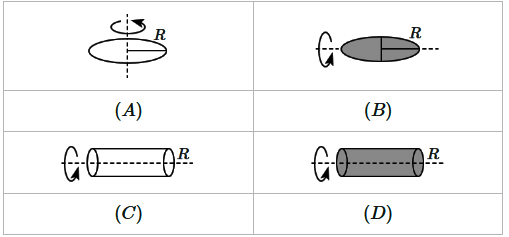 If IA , IB , IC and ID are their moments of inertia about the axis shown, then choose the correct answer from the options given below: [2024]
If IA , IB , IC and ID are their moments of inertia about the axis shown, then choose the correct answer from the options given below: [2024]
(a) IA = IC and 2IB = ID
(b)IA = 2IB and 2IC = ID
(c) 2IA = IC and IB = 2ID
(d) IA = IB = IC = 2ID
Ans: (a)
Explanation:
We are given four objects: a thin circular ring (A), a circular disc (B), a hollow cylinder (C), and a solid cylinder (D), all with the same radius (R) and the same mass (M). We need to find the relationship between their moments of inertia about the same axis.Moment of Inertia Formulas:
- Thin Circular Ring (A): Moment of inertia = MR²
- Circular Disc (B): Moment of inertia = 1/2 M R²
- Hollow Cylinder (C): Moment of inertia = MR²
- Solid Cylinder (D): Moment of inertia = 1/2 M R²
Now, let's analyze the given options:
Option (a): IA = IC and 2IB = ID
From the formulas:
- IA = MR²
- IC = M R² Hence, IA = IC is correct.
For the second part:
- 2IB = 2 × (1/2 M R²) = MR²
- ID = 1/2 × MR² Hence, 2IB = ID is correct.
So, option (a) is correct.
Final Answer: (a) IA = IC and 2IB = ID.
Q4: A body of mass 6 kg is moving from its initial position A to the next position B as shown in figure. From A to B, the value of momentum of the body is: (in SI unit) ? [2024]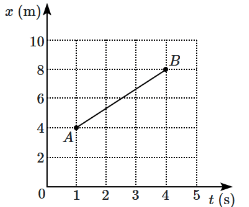
(a) 24
(b) 12
(c) 8
(d) 6
Ans: (c)
Explanation:
To find the momentum of the body at position B, we need to use the formula for momentum:
Momentum = Mass × VelocityStep 1: Calculate the velocity of the body
The graph shows a linear relationship between the position x and time t, which indicates that the body is moving with constant velocity.
We can calculate the velocity by finding the slope of the line joining points A and B, as velocity is the rate of change of position (displacement per time).From the graph:
- Position at A: xA = 4 m
- Position at B: xB = 8 m
- Time at A : tA = 1 s
- Time at B: tB = 4 s
The velocity v is given by:
v = (xB - xA) / (tB - tA)Substitute the values:
v = (8 m - 4 m) / (4 s - 1 s) = 4 m / 3 s = 4/3 m/sStep 2: Calculate the momentum
Now, we can calculate the momentum at position B using the formula for momentum:
Momentum = Mass × Velocity
Given the mass of the body is 6 kg and the velocity is 4/3 m/s, the momentum at position B is:
Momentum = 6 kg × (4/3) m/s = 8 kg·m/s
Thus, the momentum of the body at position B is 8 kg·m/s.
Final Answer: (c) 8
Q5: The radius of gyration of a solid sphere of mass 5 kg about XY - axis is 5 m as shown in the figure. If the radius of the sphere is 5x/√ 7 m , then the value of x is: [2024]
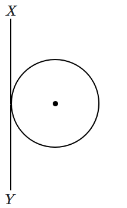 (a) 5
(a) 5
(b) √2
(c) √3
(d) √5
Ans: (d)
Explanation:
We are given the radius of gyration k = 5 m for a solid sphere, and the mass M = 5 kg. We are also given the radius of the sphere in the form R = 5x/√7 m, and we need to find the value of x.Step 1: Moment of inertia and radius of gyration
The moment of inertia I of a solid sphere about an axis passing through its center is given by the formula:
I = (2/5)MR²
The radius of gyration k is related to the moment of inertia by:
I = Mk²Step 2: Calculate moment of inertia using k = 5 m
Substitute the given value for k and M = 5 kg into the equation:
I = 5 × 5² = 125 kg·m²Step 3: Moment of inertia of the sphere
Now, use the formula for the moment of inertia of a solid sphere:
I = (2/5) M R²
Substitute the known values for I and M:
125 = (2/5) × 5 ×R²
Simplify:
125 = 2 × R²
Solve for R²:
R² = 125 / 2 = 62.5
Thus, R = √62.5.Step 4: Relate the given radius expression to the calculated radius
We are given the radius as R = 5x/√7. Equate this with R = √62.5:
5x/√7 = √62.5
Square both sides:
(5x/√7)² = 62.5
Simplify:
25x² / 7 = 62.5
Multiply both sides by 7:
25x² = 437.5
Now, divide by 25:
x² = 437.5 / 25 = 17.5
Thus, x = √17.5.
Since 17.5 ≈ 5 × √5, we get:
x = √5
Final Answer: (d) √5.
Q6: Let ω1 , ω2 and ω3 be the angular speeds of the second hand, minute hand, and hour hand of a smoothly running analog clock, respectively. If x1 , x2 and x3 are their respective angular distance in 1 minute 1 minute then the factor that remains constant (k) is:
(a) ω1/x1 = ω2/x2 = ω3/x3 = k
(b) ω1x1 = ω2x2 = ω3x3 = k
(c) ω1 x21 = ω2 x22 = ω3 x23 = k
(d) ω21 x1 = ω22 x2 = ω23 x3 = k
Ans: (a)
Explanation:
We are given the angular speeds (ω1, ω2, ω3) of the second hand, minute hand, and hour hand of a smoothly running analog clock, and the angular distances (x1, x2, x3) covered by the hands in one minute.Step 1: Understanding the problem
The angular speed is the rate at which an object moves through an angle.
The angular distance is how much angle the hand covers in a given time.
In one minute, the relation between angular speed and angular distance is:
- x1 = ω1 × 1 minute
- x2 = ω2 × 1 minute
- x3 = ω3 × 1 minute
Step 2: Relating angular speeds and angular distances
- The second hand completes 360 degrees (or 2π radians) in 60 seconds, so its angular speed (ω1) is:
ω1 = 2π / 60 radians per second- The minute hand completes 360 degrees in 3600 seconds (or 60 minutes), so its angular speed (ω2) is:
ω2 = 2π / 3600 radians per second- The hour hand completes 360 degrees in 43200 seconds (12 hours), so its angular speed (ω3) is:
ω3 = 2π / 43200 radians per secondStep 3: Relationship between angular speed and angular distance
The angular distances in one minute are:
- x1 = ω1 × 60 seconds
- x2 = ω2 × 60 seconds
- x3 = ω3 × 60 seconds
Step 4: Factor that remains constant (k)
The factor that remains constant is k, and it should be:
ω1 / x1 = ω2 / x2 = ω3 / x3 = kThus, the correct answer is (a) ω1 / x1 = ω2 / x2 = ω3 / x3 = k.
2023
Q1: The ratio of radius of gyration of a solid sphere of mass M and radius R about its own axis to the radius of gyration of the thin hollow sphere of same mass and radius about its axis is [2023](a) 3 : 5
(b) 5 : 3
(c) 2 : 5
(d) 5 : 2
Ans: (a) 3 : 5
Explanation:
The moment of inertia of a body about a given axis is related to the radius of gyration by the equation:
Where:
- = Moment of inertia
- = Mass of the body
- = Radius of gyration
For a solid sphere rotating about its own axis, the moment of inertia is given by:
For a thin hollow sphere rotating about its own axis, the moment of inertia is given by:
Now, we take the ratio of the radius of gyration of the solid sphere to the hollow sphere:
Q2: The angular acceleration of a body, moving along the circumference of a circle, is : [2023]
(a) along the radius towards the centre
(b) along the tangent to its position
(c) along the axis of rotation
(d) along the radius, away from centre
Ans: (c) along the axis of rotation
Explanation:
Angular acceleration refers to the rate of change of angular velocity of a body moving in a circular path. Angular acceleration is a vector quantity, and its direction depends on the direction of the change in angular velocity.
When a body moves along the circumference of a circle, its angular acceleration is associated with the axis of rotation, which is perpendicular to the plane of motion.
The direction of angular acceleration is the same as the direction of the change in angular velocity. For rotational motion, the axis of rotation determines the orientation of angular velocity and angular acceleration.
Q3: Two particles A and B initially at rest, move toward each other under the mutual force of attraction. At an instance when the speed of A is v and speed of B is 3v, the speed of the centre-of-mass will be: [2023]
(a) 2 v
(b) zero
(c) v
(d) 4 v
Ans: (b)
Explanation:
We are given two particles, A and B, initially at rest, moving towards each other under their mutual force of attraction. At an instant, the speed of A is v, and the speed of B is 3v. We need to find the speed of the center of mass.Step 1: Definition of the center of mass speed
The speed of the center of mass (vcm) for two particles is given by the formula:
vcm = (mA vA + mB vB) / (mA + mB)
Where:
- mA and mB are the masses of particles A and B, respectively,
- vA and vB are the velocities of particles A and B, respectively.
Since the particles are moving toward each other, we take their velocities to be in opposite directions.
Step 2: Applying the given information
- At the given instant, the speed of particle A is v, and the speed of particle B is 3v.
- Initially, both particles were at rest, so their initial momenta were zero.
Since the total momentum of the system must be conserved, the total momentum of the system is zero at any point. Therefore, the center of mass should not be moving if the system is isolated and has no external forces acting on it.
Step 3: Reasoning about the situation
- The fact that both particles started at rest and are now moving towards each other under mutual attraction means that the total momentum of the system is zero.
- Because the total momentum of the system is zero, the center of mass does not have any velocity at that moment.
Final Answer: (b) zero
The speed of the center of mass is zero.
Q4: A constant torque of 100 N-m turns a wheel of moment of inertia 300 kg-m2 about an axis passing through its centre. Starting from rest, its angular velocity after 3 s is: [2023]
(a) 1 rad/s
(b) 5 rad/s
(c) 10 rad/s
(d) 15 rad/s
Ans: (a)
Explanation:
We are given the following information:
- A constant torque (τ) of 100 N-m is applied to a wheel.
- The moment of inertia (I) of the wheel is 300 kg-m².
- The wheel starts from rest.
- We need to find the angular velocity (ω) of the wheel after 3 seconds.
Step 1: Use the relation between torque and angular acceleration
The relationship between torque (τ), moment of inertia (I), and angular acceleration (α) is given by:
τ = I α
Where:
- τ is the applied torque,
- I is the moment of inertia,
- α is the angular acceleration.
Rearranging the equation to solve for angular acceleration:
α = τ / I
Substitute the given values:
α = 100 N-m / 300 kg-m² = 1/3 rad/s²Step 2: Use the equation for angular velocity
The angular velocity (ω) after a time t, starting from rest (initial angular velocity ω₀ = 0), is given by:
ω = ω₀ + α t
Since the wheel starts from rest, ω₀ = 0. Therefore:
ω = α * t
Substitute the values for α and t:
ω = (1/3) × 3 = 1 rad/s
Final Answer: (a) 1 rad/s
2022
Q1: An energy of 484 J is spent in increasing the speed of a flywheel from 60 rpm to 360 rpm. The moment of inertia of the flywheel is
(a) 0.07 kg-m2
(b) 0.7 kg-m2
(c) 3.22 kg-m2
(c) 30.8 kg-m2
Ans: (b) 0.7 kg-m2
Explanation:
Given:Energy spent J
Initial angular speed
Final angular speed
2. The change in rotational kinetic energy is given by:
3. Substitute the known values into the equation:
Q2: The angular speed of a fly wheel moving with uniform angular acceleration changes from 1200 rpm to 3120 rpm in 16 seconds. The angular acceleration in rad/s2 is [2022]
(a) 2π
(b) 4π
(c) 12π
(d) 104π
Ans: (b) 4π
Explanation:Given:
Initial angular speed,
Final angular speed,
Time interval,
Angular acceleration α is given by the formula:
Q3: Two objects of mass 10 kg and 20 kg respectively are connected to the two ends of a rigid rod of length 10 m with negligible mass. The distance of the center of mass of the system from the 10 kg mass is [2022]
(a) 20/3 m
(b) 10 m
(c) 5 m
(d) 10/3 m
Ans: (a) 20/3 m
Explanation:
Given:Mass of the first object,
Mass of the second object, kg
Length of the rod, m
We need to find the distance of the center of mass from the 10 kg mass.
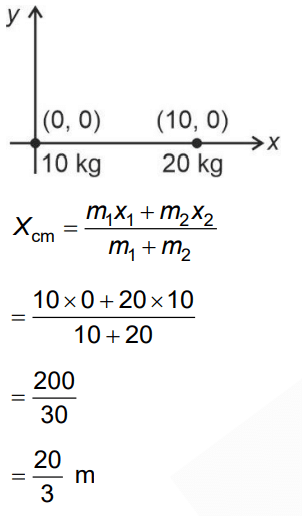
Q4: The ratio of the radius of gyration of a thin uniform disc about an axis passing through its center and normal to its plane to the radius of gyration of the disc about its diameter is [2022]
(a) √2: 1
(b) 4: 1
(c) 1: √2
(d) 2: 1
Ans: (a) √2: 1
Explanation:
2021
Q1: From a circular ring of mass 'M' and radius 'R' an arc corresponding to a 90° sector is removed. The moment of inertia of the remaining part of the ring about an axis passing through the centre of the ring and perpendicular to the plane of the ring is 'K' times 'MR2'. Then the value of 'K' is : [2021]
(a) 1/4
(b) 1/8
(c) 3/4
(d) 7/8
Ans: (c) 3/4
Explanation:
The moment of inertia of a full circular ring about its center and perpendicular to the plane is:
Since a 90° sector is removed, this represents of the total mass of the ring. The mass of the removed sector is:
The moment of inertia of the removed sector is proportional to its mass, so:
Now,
The moment of inertia of the remaining part is given as K×MR2, so:
2020
Q1: Find the torque about the origin when a force of acts on a particle whose position vector is
acts on a particle whose position vector is  [2020]
[2020]
(a) 
(b) 
(c) 
(d) 
Ans: (a) 
Explanation:
Given:
Q2: Two particles of mass 5kg and 10 kg respectively are attached to the two ends of a rigid rod of length 1m with negligible mass. The centre of mass of the system from the 5kg particle is nearly at a distance of: [2020]
(a) 67 cm
(b) 80 cm
(c) 33 cm
(d) 50 cm
Ans: (a) 67 cm
Explanation:
Given:Mass of the first particle, 5kg
Mass of the second particle, 10kg
Length of the rod, 1m =100cm
We need to find the distance of the center of mass from the 5 kg particle.
2019
Q1: A solid cylinder of mass 2 kg and radius 4 cm is rotating about its axis at the rate of 3 rpm. The torque required to stop after 2π revolutions is [2019]
(a) 2 × 10-6 N m
(b) 2 × 10-3 N m
(c) 12 × 10-4 N m
(d) 2 × 106 N m
Ans: (a) 2 × 10-6 N m
Explanation:
According to the work-energy theorem, we have:
where:
W = work done
I = moment of inertia
ωf = final angular velocity
ωi= initial angular velocity
Angular Displacement:
Moment of Inertia (for a solid cylinder):
Initial Angular velocity:
Rotational Kinetic Energy and Work Done:
The rotational kinetic energy is equal to the work done by torque (τ) over angular displacement (θ):Substituting in Eqn 1,
⇒
Q2: Two particles A and B are moving in uniform circular motion in concentric circles of radii rA and rB with speed vA and vB respectively. Their time period of rotation is the same. The ratio of angular speed of A to that of B will be: [2019]
(a) rA : rB
(b) vA : vB
(c) rB : rA
(d) 1 : 1
Ans: (d) 1 : 1
Explanation:
Q3: A disc of radius 2 m and mass 100 kg rolls on a horizontal floor. Its centre of mass has speed of 20 cm/s. How much work is needed to stop it? [2019]
(a) 1 J
(b) 2 J
(c) 3 J
(d) 30 J
Ans: (c) 3 J
Explanation:
Given:Radius of the disc, 2 m
Mass of the disc, 100 kg
Speed of the center of mass, 20 cm/s = 0.2m/s
We need to find the work required to stop the disc.
When the disc is rolling on a horizontal surface, it has both translational kinetic energy and rotational kinetic energy.
For a solid disc, the moment of inertia about its axis is:
2018
Q1: Three objects, A : (a solid sphere), B : (a thin circular disk) and C = (a circular ring), each have the same mass M and radius R. They all spin with the same angular speed ω about their own symmetry axes. The amounts of work (W) required to bring them to rest, would satisfy the relation:- [2018]
(a) WC > WB > WA
(b) WA > WB > WC
(c) WB > WA > WC
(d) WB > WA > WC
Ans: (a) WC > WB > WA
Explanation:
Q2: The moment of the force,  at (2, 0, –3), about the point (2, –2, –2), is given by:- [2018]
at (2, 0, –3), about the point (2, –2, –2), is given by:- [2018]
(a) 
(b) 
(c) 
(d) 
Ans: (d) 
Explanation:
Q3: A solid sphere is in rolling motion. In rolling motion a body possesses translational kinetic energy (Kt) as well as rotational kinetic energy (Kr) simultaneously. The ratio Kt : (Kt + Kr) for the sphere is [2018]
(a) 7 : 10
(b) 5 : 7
(c) 10 : 7
(d) 2 : 5
Ans: (b) 5 : 7
Explanation:
Given:
2017
Q1: A rope is wound around a hollow cylinder of mass 3 kg and radius 40 cm. What is the angular acceleration of the cylinder if the rope is pulled with a force of 30 N ? [2017]
(a) 0.25 rad/s2
(b) 25 rad/s2
(c) 5 m/s2
(d) 25 m/s2
Ans: (b) 25 rad/s2
Explanation:
Given:
Mass of the hollow cylinder,
M =3 kg kgM = 3 \, \text{kg} Radius of the cylinder,
mR = 40 \, \text{cm} = 0.4 \, \text{m} R = 40 cm = 0.4 mForce applied on the rope, F = 30 N
We need to find the angular acceleration α of the cylinder.
\alpha The moment of inertia I of a hollow cylinder about its axis is:
The angular acceleration is related to torque and moment of inertia by the equation:
Q2: Two discs of same moment of inertia rotating about their regular axis passing through centre and perpendicular to the plane of disc with angular velocities ω1 and ω2. They are brought into contact face to face coinciding the axis of rotation. The expression for loss of energy during this process is:- [2017]
(a) 
(b)
(c) 
(d) 
Ans: (a) 
Explanation:
The initial kinetic energy of the system (both discs) before being brought into contact is:
When the two discs are brought into contact and rotate together, the total angular momentum is conserved. Therefore:
After the discs are brought into contact, the final kinetic energy of the system is:
The energy lost during the process is the difference between the initial and final kinetic energies:
Q3: Which of the following statements are correct ? [2017]
(a) Centre of mass of a body always coincides with the centre of gravity of the body
(b) Central of mass of a body is the point at which the total gravitational torque on the body is zero
(c) A couple on a body produces both translational and rotation motion in a body
(d) Mechanical advantage greater than one means that small effort can be used to lift a large load
(a) (a) and (b)
(b) (b) and (c)
(c) (c) and (d)
(d) (b) and (d)
Ans: (d) (b) and (d)
Explanation:
(a) Centre of mass of a body always coincides with the centre of gravity of the body:False: The center of mass and the center of gravity coincide only in a uniform gravitational field. In non-uniform fields, they may not coincide because the center of gravity depends on the distribution of gravitational forces.
(b) Centre of mass of a body is the point at which the total gravitational torque on the body is zero:
True: The center of mass is the point where all the mass of the body can be considered to be concentrated, and the total gravitational torque about this point is zero.
(c) A couple on a body produces both translational and rotational motion in a body:
False: A couple consists of two equal and opposite forces whose lines of action do not coincide. A couple produces only rotational motion without any translational motion, as the net force is zero but the net torque is not.
(d) Mechanical advantage greater than one means that small effort can be used to lift a large load:
True: Mechanical advantage (MA) is the ratio of load to effort. When MA is greater than 1, a small effort is sufficient to lift a large load, making it easier to perform the task.
Conclusion:
(b) is true because the center of mass is the point where the total gravitational torque is zero.
(d) is true because mechanical advantage greater than 1 means a small effort can lift a large load.
2016
Q1: From a disc of radius R and mass M1 a circular hole of diameter R1 whose rim passes through the centre is cut. What is the moment of inertia of the remaining part of the disc about at perpendicular axis, passing through the centre ? [2016]
(a) 9MR2/32
(b) 15MR2/32
(c) 13MR2/32
(d) 11 MR2/32
Ans: (c) 13MR2/32
Explanation:
Option C is correct Answer.
Q2: A disk and a sphere of same radius but different masses roll off on two inclined planes of the same altitude and length. Which one of the two objects gets to the bottom of the plane first ? [2016]
(a) Depends on their masses
(b) Disk
(c) Sphere
(d) both reach at the same time
Ans: (c) Sphere
Explanation:
Q3: A uniform circular disc of radius 50 cm at rest is free to turn about an axis which is perpendicular to its plane and passes through its centre. It is subjected to a torque which produces a constant angular acceleration of 2.0 rad s-2. Its net acceleration in ms-2 at the end of 2.0 s is approximately : [2016]
(a) 3.0
(b) 8.0
(c) 7.0
(d) 6.0
Ans: (b) 8.0
Explanation:
The angular speed of disc increases with time, and hence centripetal acceleration also increases.
Q4: A light rod of length l has two masses m1 and m2 attached to its two ends. The moment of inertia of the system about an axis perpendicular to the rod and passing through the centre of mass is [2016]
(a) 
(b) 
(c) 
(d) 
Ans: (a) 
Explanation:
Q5: A solid sphere of mass m and radius R is rotating about its diameter. A solid cylinder of same mass and same radius is also rotating about its geometrical axis with an angular speed twice that of the sphere. The ratio of their kinetic energies of rotation (Esphere / Ecylinder) will be [2016]
(a) 2 : 3
(b) 1 : 5
(c) 1 : 4
(d) 3 : 1
Ans: (b) 1 : 5
Explanation:
2015
Q1: Three identical spherical shells, each of mass m and radius r are placed as shown in figure. Consider an axis XX' which is touching to two shells and passing through diameter of third shell. Moment of inertia of the system consisting of these three spherical shells about XX' axis is : [2015]
(a) 4 mr2
(b) 11/5 mr2
(c) 3 mr2
(d) 16/5 mr2
Ans: (a) 4 mr2
Explanation:
Similarly the moment of inertia of the spherical shell C about the XX' axis is
Q2: A rod of weight W is supported by two parallel knife edges A and B and is in equilibrium in a horizontal position. The knives are at a distance d from each other. The centre of mass of the rod is at distance x from A. The normal reaction on A is [2015]
(a) 
(b) 
(c) 
(d) 
Ans: (b) 
Explanation:
Given situation is shown in figure.
N1 = Normal reaction on A
N2 = Normal reaction on B
W = Weight of the rod
In vertical equilibrium,
N1 + N2 = W …(i)
Torque balance about centre of mass of the rod,
N1x = N2(d – x)
Putting value of N2 from equation (i)
N1x = (W – N1)(d – x)N1x = Wd – Wx – N1d + N1x ⇒ N1d = W(d – x) ⇒
Q3: Three identical spherical shells, each of mass m and radius r are placed as shown in figure. Consider an axis XX' which is touching to two shells and passing through diameter of third shell. Moment of inertia of the system consisting of these three spherical shells about XX' axis is [2015]
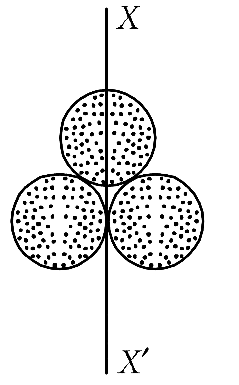
(a) 16/5mr2
(b) 4mr2
(c) 11/5mr2
(d) 3mr2
Ans: (b) 4mr2
Explanation:
Net moment of inertia of the system,
I = I1 + I2 + I3
The moment of inertia of a shell about its diameter,
Q4: An automobile moves on a road with a speed of 54 km h
(a) 10.86 kg m2 s
(b) 2.86 kg m2 s
(c) 6.66 kg m2 s
(d) 8.58 kg m2 s
Ans: (c) 6.66 kg m2 s
Explanation:
Here, Speed of the automobile,
Radius of the wheel of the automobile, R = 0.45 m
Moment of inertia of the wheel about its axis of rotation, I = 3 kg m2
Time in which the vehicle brought to rest, t = 15 s
The initial angular speed of the wheel is
Q5: A force  is acting at a point
is acting at a point  . The value of αfor which angular momentum about origin is conserved is [2015]
. The value of αfor which angular momentum about origin is conserved is [2015]
(a) Zero
(b) 1
(c) -1
(d) 2
Ans: (c) -1
Explanation:
From Newton's second law for rotational motion,
2014
Q1: A solid cylinder of mass 50 kg and radius 0.5 m is free to rotate about the horizontal axis. A massless string is wound round the cylinder with one end attached to it and other hanging freely. Tension in the string required to produce an angular acceleration of 2 revolutions s−2 is: [2014]
(a) 78.5 N
(b) 157 N
(c) 25 πN
(d) 50 N
Ans: (b) 157 N
Explanation:
Q2: The ratio of the accelerations for a solid sphere (mass ‘m’ and radius ‘R’) rolling down an incline of angle ‘θ’ without slipping and slipping down the incline without rolling is : [2014]
(a) 2 : 5
(b) 7 : 5
(c) 5 : 7
(d) 2 :3
Ans: (c) 5 :7
Explanation:
Q3: A body of mass (4m) is lying in x−y plane at rest. It suddenly explodes into three pieces. Two pieces, each of mass (m) move perpendicular to each other with equal speeds (ν). The total kinetic energy generated due to explosion is : [2014]
(a) 2 mν2
(b) 4 mν2
(c) mν2
(d) 3/2 mν2
Ans: (d) 3/2 mv2
Explanation:
|
95 videos|367 docs|98 tests
|
FAQs on NEET Previous year questions (2014-2025): System of Particles & Rotational Motion - Physics Class 11
| 1. What are the key concepts of System of Particles in NEET Physics? |  |
| 2. How do I calculate the center of mass for a system of particles? |  |
| 3. What is the importance of rotational motion in NEET exams? |  |
| 4. How do I solve problems related to torque and moment of inertia? |  |
| 5. What are some common types of questions asked in NEET regarding System of Particles and Rotational Motion? |  |


